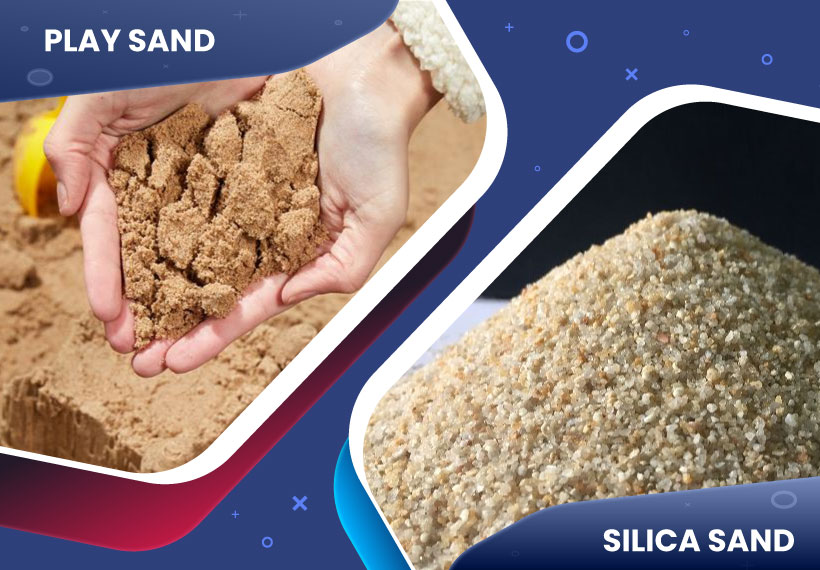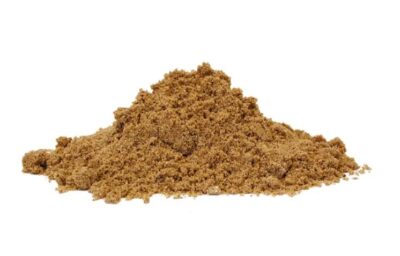Exploring the Differences: Silica Sand vs. Play Sand

Sand might seem simple and familiar, but there’s more to it than meets the eye. When you delve into the world of sands, you’ll discover that not all sands are created equal.
Two types of sand that often confuse are silica sand and play sand. Although they might appear similar, they serve distinct purposes and have unique characteristics.
This article examines the differences between silica sand and play sand, helping you understand when and where to use each type.
Understanding the Importance of Sand
Sand is not just a grainy substance but crucial in various aspects of our lives. From construction to recreation, sand finds its way into numerous applications.
However, not all sand is suitable for all purposes. Two common types of sand that are often misunderstood are silica sand and play sand.
Different Types of Sand for Different Needs
Whether you’re building structures, creating play areas, or crafting artistic pieces, the type of sand you use matters.
Silica sand and play sand are two categories that cater to different requirements. Let’s delve deeper into what sets them apart.
Silica Sand: What Sets It Apart

Composition and Properties
Silica sand, also known as industrial sand, is primarily composed of silicon dioxide. It’s characterized by its granular texture and high silica content. These properties make it a preferred choice for various industrial applications.
Industrial Applications
Silica sand is a key ingredient in glass manufacturing, metal casting, and hydraulic fracturing (fracking) for oil and gas extraction. Its uniform particles and heat-resistant nature are critical for these processes.
Safety Considerations
While silica sand is versatile, handling it with caution is essential. Prolonged inhalation of silica dust can lead to respiratory issues, such as silicosis. Thus, proper safety measures are crucial when working with silica sand.
Play Sand: Unveiling its Nature

Composition and Features
Play sand, also called sandbox sand, is designed for recreational use. It’s typically composed of finely ground quartz and other minerals.
Play sand has a softer and smoother texture, making it ideal for children’s play areas.
Use in Playgrounds and Recreational Areas
Play sand’s gentle texture, and natural look make it a popular choice for playgrounds and recreational spaces. It provides an enjoyable sensory experience for children and encourages imaginative play.
Child Safety and Health Concerns
When choosing play sand, safety is paramount. Ensure that the sand is non-toxic and free from contaminants. Regular maintenance, including sifting and cleaning, helps keep the play area safe for children.
Comparing Silica Sand and Play Sand
Grain Size and Texture
One of the primary distinctions between the two grains of sand is their grain size and texture. Silica sand has a coarser texture due to its larger grains, while play sand has finer particles, creating a softer feel.
Intended Uses and Environments
Silica sand’s durability and heat resistance makes it suitable for industrial applications. In contrast, play sand’s softer texture and child-friendly characteristics make it perfect for recreational spaces and play areas.
Safety Factors and Regulations
Both sands come with safety considerations. Silica sand poses inhalation risks, especially in industrial settings.
Play sand’s potential health concerns are related to children’s exposure to contaminants, emphasizing the need for vigilance in play areas.
Landscaping and Gardening: Which Sand to Choose
Soil Aeration and Drainage
Silica sand can improve soil drainage and aeration when mixed in garden soil. Its coarse particles help prevent compaction and enhance root growth.
Mixing with Potting Soil
Mixing silica sand with potting soil in gardening can enhance drainage and provide a suitable medium for plants that require well-draining conditions.
Creating Sand Gardens
Play sand can be used creatively in landscaping to create unique sand gardens. Its fine texture allows for intricate designs and patterns.
Construction Applications: Making the Right Selection
Concrete Mixing and Strength
Silica sand’s coarse nature contributes to concrete strength. It provides stability and prevents the concrete from cracking during curing.
Bricklaying and Masonry
Play sand’s fine texture makes it helpful in mixing mortar in bricklaying and masonry work. It helps achieve smooth finishes.
Joint Filling and Paver Installation
Play sand is often used in paver installation to fill joints between pavers, providing stability and preventing shifting.
Artificial Beaches and Recreational Areas
Creating Realistic Beach Settings
Play sand is a staple in creating artificial beaches, bringing the feel of a beach to landlocked areas.
Volleyball Courts and Sand Sports
Play sand’s soft texture makes it popular for sports like volleyball, providing a comfortable playing surface.
Home Improvement Projects: Tips and Tricks
DIY Sandbox for Kids
Create a safe and enjoyable play area for kids by using play sand to build a DIY sandbox in your backyard.
Paver Patio Construction
For a sturdy paver patio, please choose a suitable sand, whether silica sand for stability or play sand for joint filling.
Aquariums and Pet Habitats
Substrate for Aquariums
Silica sand can serve as an aquarium substrate, providing a natural look and aiding in maintaining water quality.
Reptile Enclosures
Play sand can mimic the natural habitat of desert-dwelling reptiles, creating a comfortable enclosure.
Environmental Impact and Sustainability
Mining and Extraction Concerns
Both silica sand and play sand extraction can have environmental implications, including habitat disruption and water pollution.
Reusing and Recycling Sand
Efforts to reuse and recycle sand can mitigate environmental impacts. Proper disposal and sand reclamation processes are vital.
Choosing the Right Sand for Your Needs
Considering Project Requirements
When choosing between silica sand and play sand, consider the specific needs of your project, including texture, durability, and safety.
Weighing Safety and Environmental Factors
Prioritize safety for workers and users, and consider the environmental impact of your sand choice.
FAQs About Silica Sand and Play Sand
Is play sand safe for my children?
Play sand can be safe for children’s play areas if appropriately sourced, clean, and regularly maintained. Ensure it’s free from contaminants.
Can I use silica sand for my paver patio?
Using silica sand for your paver patio’s base layer can enhance stability and prevent shifting.
What’s the difference between sandbox sand and play sand?
Sandbox sand and play sand are often used interchangeably. However, play sand is designed to be safer and softer for children’s play.
How can I tell if sand is silica sand?
Silica sand has a coarse texture and is primarily composed of silicon dioxide. You can perform simple tests like feeling the texture and observing the color.
Can I replace play sand with silica sand in my child’s sandbox?
It’s not recommended to replace play sand with silica sand in a child’s sandbox due to the potential health risks of silica dust.
Conclusion
In the world of sand, the choices are more nuanced than they seem. Silica sand and play sand have distinct qualities, making them suitable for different applications.
Whether you’re constructing, landscaping, or engaging in recreational activities, understanding the differences between these sands will help you make informed decisions, ensuring safety and optimal performance for your projects.

